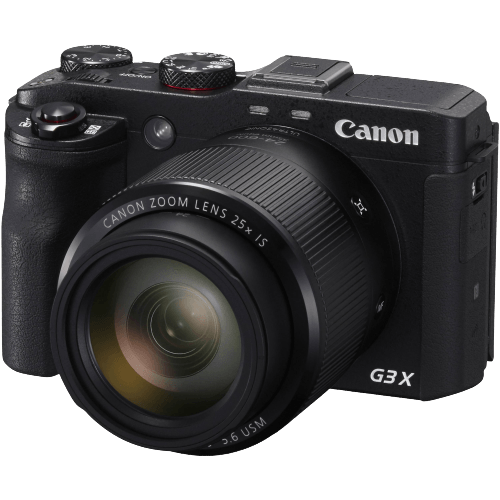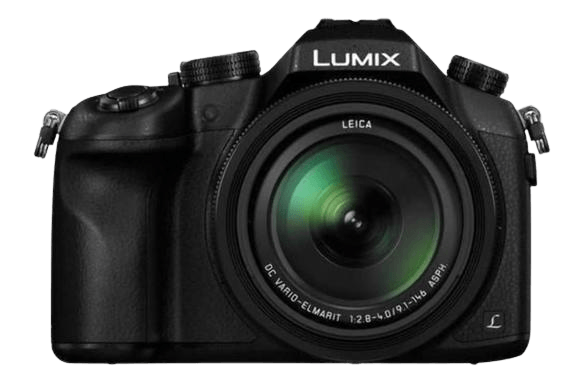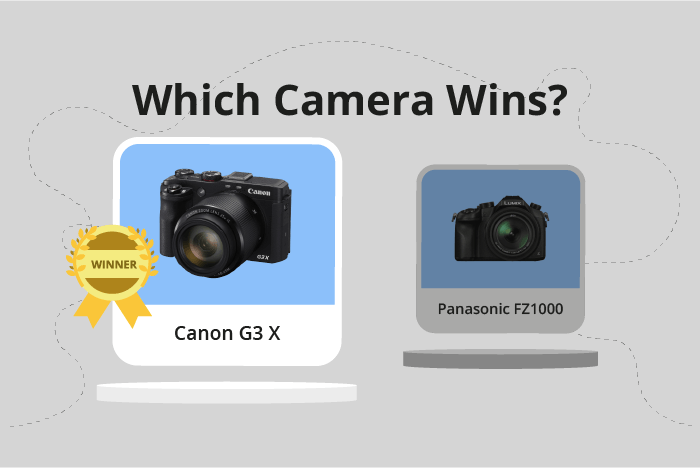Canon PowerShot G3 X vs Panasonic Lumix DMC-FZ1000 Comparison
Canon PowerShot G3 X

Panasonic Lumix DMC-FZ1000

The Canon PowerShot G3 X outperforms the Panasonic Lumix DMC-FZ1000 with a score of 62/100 compared to 57/100. Both cameras are bridge type and share a similar release period, with the G3 X launching in 2015 and the FZ1000 in 2014. The G3 X has a smaller and lighter design, measuring 123 x 77 x 105mm and weighing 733g, while the FZ1000 measures 137 x 99 x 131mm and weighs 831g.
The Canon G3 X’s higher score reflects its advantages, including a more compact and lightweight build. On the other hand, the Panasonic FZ1000 has a lower launch price of $899 compared to the G3 X’s $999. Despite the price difference, the Canon G3 X’s superior performance justifies its higher score.
Canon PowerShot G3 X vs Panasonic Lumix DMC-FZ1000 Overview and Optics
The Panasonic Lumix DMC-FZ1000 outperforms the Canon PowerShot G3 X in optics with a score difference of 4 points (61/100 vs 57/100). Both cameras share common specifications, such as 20 megapixels, CMOS sensor type, 1″ sensor size, a fixed lens mount, and image stabilization. However, there are differences that set these two cameras apart.
The FZ1000 has a faster shooting speed of 12 compared to the G3 X’s 5.9, allowing it to capture more images in a shorter time span. Additionally, the FZ1000’s Venus Engine processor contributes to its higher optical score, providing better image processing. Its DXOMARK score for the sensor is also slightly higher at 64, compared to the G3 X’s 63, indicating better sensor performance.
On the other hand, the Canon PowerShot G3 X features a DIGIC 6 processor, which, although not as powerful as the FZ1000’s Venus Engine, still delivers good image processing. Despite having a slightly lower DXOMARK sensor score, it is comparable to the FZ1000’s sensor performance.
Taking these differences into account, the Panasonic Lumix DMC-FZ1000 is the better camera in terms of optics, mainly due to its faster shooting speed and superior processor. However, the Canon PowerShot G3 X is not far behind, and its optical performance is still commendable. Both cameras have their strengths and weaknesses, and the final choice depends on the individual’s priorities and preferences.
Canon PowerShot G3 X vs Panasonic Lumix DMC-FZ1000 Video Performance
The Panasonic Lumix DMC-FZ1000 outperforms the Canon PowerShot G3 X in video capabilities, as evidenced by its higher video score of 83, compared to the G3 X’s score of 70. Both cameras share some common specs, such as a maximum video frame rate of 60fps and built-in time-lapse functionality, but there are key differences that make the FZ1000 superior in this category.
The most significant advantage of the FZ1000 is its 4K video resolution, which is a considerable step up from the G3 X’s Full HD resolution. With a maximum video dimension of 3840 x 2160, the FZ1000 offers greater detail and clarity in its video output, making it a more appealing choice for those who prioritize video quality.
While the Canon PowerShot G3 X does not surpass the FZ1000 in any specific video-related spec, it still offers respectable video capabilities with its Full HD resolution and maximum video dimensions of 1920 x 1080. For users who do not require 4K resolution, the G3 X remains a viable option.
Evaluating the video capabilities of both cameras, it is clear that the Panasonic Lumix DMC-FZ1000 is the superior choice for those who prioritize video quality, due to its 4K resolution and higher video score. However, the Canon PowerShot G3 X still offers decent video performance with its Full HD resolution and might be suitable for users who do not require the additional detail provided by 4K.
Canon PowerShot G3 X vs Panasonic Lumix DMC-FZ1000 Features and Benefits
The Canon PowerShot G3 X outperforms the Panasonic Lumix DMC-FZ1000 in features, scoring 87/100 compared to the Lumix’s 58/100. Both cameras share several specifications, such as flip screens, Wi-Fi, and Bluetooth connectivity. Neither camera has GPS functionality.
The PowerShot G3 X stands out due to its 3.2-inch touchscreen, which is larger than the Lumix’s 3-inch non-touchscreen. Additionally, the G3 X has a higher screen resolution of 1,620,000 dots, compared to the Lumix’s 2,359,000 dots. The touchscreen and higher resolution provide the G3 X with a more user-friendly interface and better image preview quality.
On the other hand, the Lumix DMC-FZ1000 does not have any notable advantages over the PowerShot G3 X in terms of features. Both cameras are on equal footing in connectivity options and flip screen functionality. The absence of a touchscreen and the lower screen resolution make the Lumix less appealing in comparison.
Taking into account the differences in feature scores, the Canon PowerShot G3 X is the superior camera in this comparison. Its larger touchscreen and higher screen resolution contribute to a more enjoyable user experience. The Panasonic Lumix DMC-FZ1000, while offering similar connectivity options, falls short due to its lack of touchscreen and lower screen resolution.
Canon PowerShot G3 X vs Panasonic Lumix DMC-FZ1000 Storage and Battery
The Panasonic Lumix DMC-FZ1000 outperforms the Canon PowerShot G3 X in storage and battery, scoring 21/100 compared to the G3 X’s 16/100. Both cameras share similarities in their storage capabilities, with each having one memory card slot and accepting SD, SDHC, and SDXC cards. However, the FZ1000 has a longer battery life, allowing for 360 shots, while the G3 X only provides 300 shots. This difference makes the FZ1000 a more reliable option for extended use.
While the G3 X falls behind in battery life, it does offer compatibility with UHS-I memory cards, providing faster read and write speeds. This advantage is not significant enough to outweigh the FZ1000’s superior battery life.
Considering storage and battery performance, the Panasonic Lumix DMC-FZ1000 is the better choice due to its longer battery life. The Canon PowerShot G3 X’s advantage of UHS-I compatibility is not substantial enough to make up for its shorter battery life.
Canon PowerShot G3 X vs Panasonic Lumix DMC-FZ1000 – Our Verdict
Are you still undecided about which camera is right for you? Have a look at these popular comparisons that feature the Canon PowerShot G3 X or the Panasonic Lumix DMC-FZ1000:

